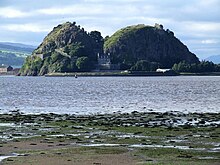Dumbarton Castle
Dumbarton Castle is a castle or fortress in the Scottish town of Dumbarton in the council area of West Dunbartonshire . The complex occupies a striking basalt rock of volcanic origin on the banks of the Clyde at the mouth of the Leven . In 1971 the building was included in the Scottish List of Monuments in the highest category A. Furthermore, the castle has been protected as a Scheduled Monument since 1994 .
history
The history of fortifications on Dumbarton Rock can be traced back over 1500 years. At that time the kingdom of Alt Clut (Strathclyde) was ruled from this hill. The earliest known of these rulers was Ceretic Guletic in the fifth century. Legend has it that the mythical wizard Merlin stayed there in the 6th century at King Rhydderch Hael's court. At the time of the Viking attacks on Britain, the hill was besieged several times. Olaf the White and Ivar the Boneless succeeded in sacking the fortress in 870 after a four-month siege. As part of several archaeological investigations of the site, numerous artifacts from this period were found, including a Norwegian lead weight and a sword pommel.
Later the hill developed into an important fortress site. Thus, on the instructions of King Alexander II , the fortress Dun Breatann ("Fortress of the British") was built in the 1220s to secure the border with the Norwegian occupied territories, 16 km away. The city name "Dumbarton" is derived from this name. After the Norwegian threat was largely eliminated after the Battle of Largs , the fortress appeared stripped of its livelihood. However, the Scottish Wars of Independence followed , in which Dun Breatann represented a safe haven away from the border region. There is evidence that the Scottish freedom fighter William Wallace was held captive in the fortress for some time in 1305 before he was taken to London for his execution . Both King David II. 1305 and Queen Maria Stuart 1548 used the protection of Dun Breatann to flee to France.
With the return of Queen Mary in 1561, the fortress lost its importance. Maria landed in Leith (now Edinburgh ) and ruled the country from there, so that the mouth of the Clyde was far from the center of power. Nevertheless, troops were always stationed there. In the 17th century the fortress was completely rebuilt and got its current appearance. In November 1645 the Committee of Estates increased the guard by 30 men. After Oliver Cromwell's death in 1658, the castle continued to lose importance.
Changes were made in the 18th and 19th centuries. The last military act took place during World War II . Dumbarton Castle has twice been chosen as the location for feature films. Parts of Gregory's Two Girls were filmed there, while the fortress was used as a hiding place for German spies in the BBC production The 39 Steps .
Individual evidence
- ↑ Listed Building - Entry . In: Historic Scotland .
- ↑ Scheduled Monument - Entry . In: Historic Scotland .
- ↑ Norman Davies : Vanished Empires: The History of Forgotten Europe. 3rd, revised and corrected edition. Theiss, Darmstadt 2017, ISBN 978-3-8062-3116-8 , pp. 62-66.
- ^ A b c Information from Historic Scotland
- ↑ a b Entry on Dumbarton Castle in Canmore, the database of Historic Environment Scotland (English)
- ^ D. Stevenson: Government of Scotland under the Covenanters, (SHS Edinburgh, 1982) pp. 34-5
- ^ Entry in the Gazetteer for Scotland
Web links
- Entry on Dumbarton Castle in Canmore, Historic Environment Scotland database
Coordinates: 55 ° 56 ′ 9.7 ″ N , 4 ° 33 ′ 46 ″ W.


